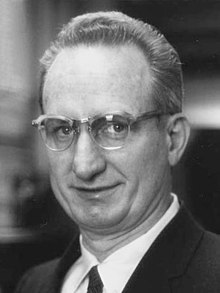James Rainwater
Leo James Rainwater | |
|---|---|
 Rainwater in 1975 | |
| Born | December 9, 1917 Council, Idaho, U.S. |
| Died | May 31, 1986 (aged 68) New York City, U.S. |
| Education | California Institute of Technology (BA) Columbia University (MA, PhD) |
| Awards | Ernest Orlando Lawrence Award (1963) Nobel Prize in Physics (1975) |
| Scientific career | |
| Institutions | Columbia University Manhattan Project |
| Thesis | Neutron beam spectrometer studies of boron, cadmium, and the energy distribution from paraffin (1946) |
| Doctoral advisor | John R. Dunning |
Leo James Rainwater (December 9, 1917 – May 31, 1986) was an American physicist who shared the
During
Rainwater joined the physics faculty at Columbia in 1946, where he reached the rank of full professor in 1952 and was named Pupin Professor of Physics in 1982. He received the Ernest Orlando Lawrence Award for Physics in 1963 and in 1975 was awarded the Nobel Prize in Physics, "for the discovery of the connection between collective motion and particle motion in atomic nuclei and the development of the theory of the structure of the atomic nucleus based on this connection".[1]
Early life
Leo James Rainwater was born on December 9, 1917, in Council, Idaho, the son of a former civil engineer who ran the local general store,[2] Leo Jaspar Rainwater and his wife Edna Eliza née Teague.[3] He never used his first name and was always referred to as James or Jim. His father died in the great influenza epidemic of 1918 and Rainwater and his mother moved to Hanford, California, where she married George Fowler, a widower with two sons, Freeman and John. In time he also acquired a half-brother, George Fowler Jr., who became naval officer. At high school he excelled in mathematics, chemistry and physics and was admitted to the California Institute of Technology on the strength of a chemistry competition.[3][4] He received his Bachelor of Science degree as a physics major in 1939.[5]
Manhattan Project
Rainwater then chose to undertake postgraduate studies at Columbia University. At the time this was an unusual move for a scholar from California, as Columbia was not then renowned for its physics; but this had recently changed. George B. Pegram had recently built up the physics department, and hired scientists like Enrico Fermi.[4] At Columbia Rainwater studied under Isidor Isaac Rabi, Enrico Fermi, Edward Teller and John R. Dunning.[2] Fermi was engaged in neutron moderator studies that would lead to the construction of the first nuclear reactor, while Dunning and Eugene T. Booth had built Columbia's first cyclotron, in the basement of the Pupin Physics Laboratories.[6] Rainwater received his Master of Arts in 1941.[5] For his Doctor of Philosophy thesis on "Neutron beam spectrometer studies of boron, cadmium, and the energy distribution from paraffin",[7] written under Dunning's supervision, he built a neutron spectrometer and developed techniques for its use.[6] Rainwater married Emma Louise Smith in March 1942.[2] They had three sons, James, Robert and William and a daughter, Elizabeth Ann, who died from leukaemia when she was nine.[8]
Fermi's reactor group moved to the
Later life
Rainwater remained at Columbia as an instructor. In 1948, he began teaching courses on nuclear structure.
When I made my proposal for use of a spheroidal nuclear model, it seemed to be an obvious answer which would immediately be simultaneously suggested by all theorists in the field. I do not understand why it was not. I was also surprised and dismayed to hear one or more respected theorists announce in every Nuclear Physics Conference which I attended through 1955 some such comment as, "Although the Nuclear Shell Model seems empirically to work very well, there is at present no theoretical justification as to why it should apply."[16]
With funding from the
He was a fellow of the
Rainwater succeeded Robert R. Wilson as Michael I. Pupin Professor of Physics in 1983.[21]
Rainwater collapsed after a lecture at the Pupin Laboratories in 1985 but was revived by a student who knew how to administer
Notes
- ^ "The Nobel Prize in Physics 1975". Nobel Foundation. Retrieved January 16, 2014.
- ^ a b c d e f g "James Rainwater – Biographical". Nobel Foundation. Retrieved March 28, 2015.
- ^ a b c "James Rainwater". Soylent Communications. Retrieved March 28, 2015.
- ^ a b Fitch 2009, pp. 3–4.
- ^ a b "L. James Rainwater". Array of Contemporary American Physicists. Archived from the original on December 22, 2015. Retrieved March 28, 2015.
- ^ a b Fitch 2009, p. 5.
- OCLC 77870480. Retrieved March 28, 2015.
- ^ Fitch 2009, p. 14.
- ^ Fitch 2009, p. 18.
- .
- .
- ^ a b c d Havens 1986, p. 142.
- .
- .
- ^ "The Nobel Prize in Physics 1975 – Award Ceremony Speech". Nobel Foundation. Retrieved March 28, 2015.
- ^ James Rainwater on Nobelprize.org including the Nobel Lecture, December 11, 1975 Background for the Spheroidal Nuclear Model Proposal
- ^ a b Fitch 2009, p. 15.
- .
- .
- ^ Fitch 2009, p. 16.
- ^ New York Times. Retrieved March 28, 2015.
References
- Fitch, Val L. (2009). James Rainwater: 1917–1986 (PDF). Biographical Memoirs of the National Academy of Sciences. National Academy of Sciences. Retrieved March 28, 2013.
- .
External links
- James Rainwater on Nobelprize.org including the Nobel Lecture, December 11, 1975 Background for the Spheroidal Nuclear Model Proposal
Related archival collections
- Haskell A. Reich collection of student notes, circa 1945-1954, Niels Bohr Library & Archives (includes lecture notes from James Rainwater's courses at Columbia University)
